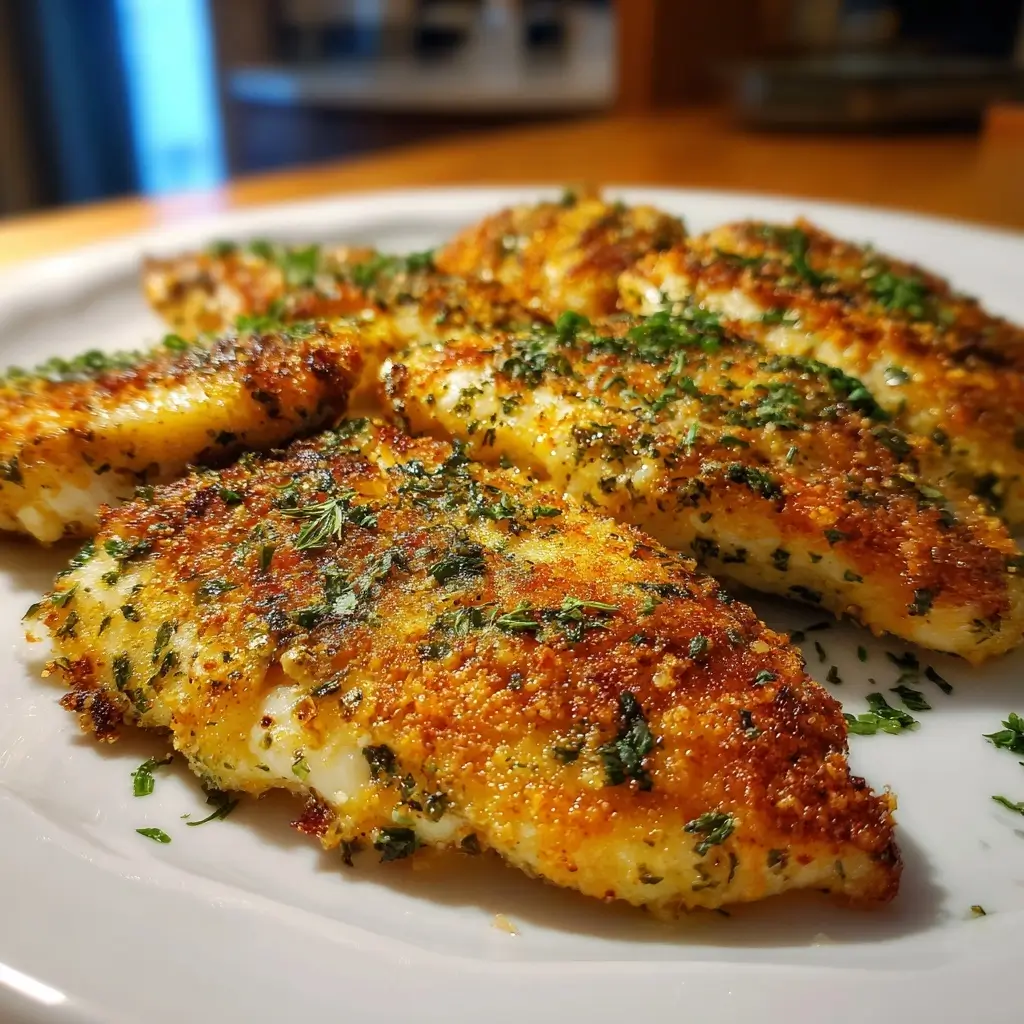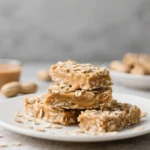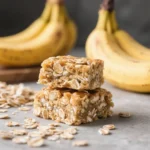Tilapia Parmesan: A Light, Flavorful Twist on a Classic Favorite
Tilapia Parmesan is a modern, health-conscious adaptation of the beloved Italian-American classic, Chicken Parmesan. This dish brings together the delicate, mild flavor of tilapia fillets with the rich, savory goodness of tomato sauce and melted cheese, creating a meal that’s both satisfying and nutritious. Perfect for weeknight dinners or weekend entertaining, Tilapia Parmesan offers a lighter alternative without sacrificing taste. With its golden-breadcrumb crust, bubbling mozzarella, and fragrant herbs, this dish delivers comfort in every bite—while keeping things heart-healthy and low in saturated fat.
The History Behind the Dish
The origins of “Parmesan” dishes trace back to Southern Italy, particularly the Campania region, where eggplant Parmigiana (Melanzane alla Parmigiana) was a staple. This traditional casserole featured layers of fried eggplant, tomato sauce, basil, and hard cheeses like Parmigiano-Reggiano. As Italian immigrants brought their culinary traditions to America in the late 19th and early 20th centuries, they adapted recipes using locally available ingredients and American tastes. Chicken Parmesan emerged as a popular fusion dish—likely in mid-20th century New York or New Jersey—substituting breaded and fried chicken cutlets for eggplant.
Over time, home cooks and chefs began experimenting with other proteins, leading to versions made with veal (Veal Parmigiana), pork, and eventually fish. Tilapia, a mild-flavored freshwater fish, became a popular choice due to its affordability, availability, and adaptability to various seasonings. Tilapia Parmesan reflects contemporary dietary preferences—offering a lean protein option that aligns with heart-healthy eating patterns while maintaining the comforting essence of its Italian roots.
Ingredients Breakdown: What Makes This Dish Shine
The success of Tilapia Parmesan lies in the balance of simple, high-quality ingredients. Each component plays a crucial role in building flavor, texture, and nutritional value:
- Tilapia Fillets: The star ingredient, known for its tender texture and neutral flavor, absorbs seasonings beautifully and pairs well with bold sauces and cheeses.
- Breadcrumbs: Used for coating, they create a crispy exterior when baked or lightly pan-fried. Panko breadcrumbs offer extra crunch, while whole wheat adds fiber.
- Grated Parmesan Cheese: Adds umami depth and helps bind the breading to the fish. Authentic Parmigiano-Reggiano enhances flavor, but a good-quality domestic version works too.
- Mozzarella Cheese: Provides that signature gooey, melty layer on top. Fresh mozzarella gives a creamier texture, while low-moisture shredded mozzarella ensures even melting.
- Marinara Sauce: A rich, herb-infused tomato base ties the dish together. Homemade sauce allows control over sodium and sugar; store-bought options should be low-sodium and free from artificial additives.
- Eggs: Act as a binder, helping the breadcrumb mixture adhere to the fish fillets.
- Garlic and Herbs: Fresh or dried oregano, basil, parsley, and garlic powder elevate the flavor profile with aromatic complexity.
- Olive Oil: Used sparingly for baking or pan-searing, it adds heart-healthy monounsaturated fats and aids in achieving a golden crust.
Optional enhancements include lemon zest for brightness, red pepper flakes for heat, capers for brininess, or fresh spinach layered beneath the fish for added nutrients.
Step-by-Step Recipe: How to Make Perfect Tilapia Parmesan at Home
- Prep the Ingredients: Preheat your oven to 400°F (200°C). Line a baking sheet with parchment paper or lightly grease it with olive oil. Pat the tilapia fillets dry with paper towels to ensure the coating sticks properly.
- Set Up Your Breading Station: Prepare three shallow bowls. In the first, place flour (about 1/4 cup). In the second, beat 2 large eggs with a tablespoon of water. In the third, combine 1 cup of breadcrumbs, 1/2 cup grated Parmesan cheese, 1 teaspoon garlic powder, 1 teaspoon dried oregano, 1/2 teaspoon paprika, and salt and pepper to taste.
- Bread the Fish: Dredge each tilapia fillet in flour, shaking off excess. Dip into the egg mixture, allowing excess to drip off. Finally, press into the breadcrumb mixture, coating both sides evenly. Place on the prepared baking sheet.
- Lightly Coat with Oil: Spray or brush the tops of the breaded fillets with olive oil or cooking spray. This helps achieve a golden, crisp crust during baking.
- Bake Until Crispy: Bake for 12–15 minutes, or until the fish is opaque and flakes easily with a fork, and the coating is golden brown.
- Add Sauce and Cheese: Remove from oven. Spoon about 2 tablespoons of warm marinara sauce over each fillet, then sprinkle generously with shredded mozzarella and an extra pinch of Parmesan.
- Melt the Cheese: Return to the oven and bake for an additional 5–7 minutes, until the cheese is bubbly and slightly browned.
- Garnish and Serve: Let rest for 2–3 minutes. Garnish with chopped fresh basil, parsley, or a squeeze of lemon juice. Serve immediately.
Tips for Success: Expert Advice for the Best Results
- Choose High-Quality Tilapia: Look for firm, translucent fillets with no strong odor. If possible, opt for sustainably farmed tilapia certified by organizations like Aquaculture Stewardship Council (ASC).
- Don’t Skip the Flour Step: Even though tilapia is delicate, the initial flour dredge helps the egg adhere better, which improves breading consistency.
- Use Panko for Extra Crunch: Substitute regular breadcrumbs with panko for a lighter, crispier texture.
- Avoid Overbaking: Tilapia cooks quickly and can dry out if left too long in the oven. Check for doneness early.
- Bake, Don’t Fry: For a healthier version, baking is ideal. However, for a more authentic texture, lightly pan-sear the breaded fillets in olive oil before finishing in the oven.
- Warm the Sauce: Cold sauce lowers the oven temperature and can make the dish soggy. Always heat your marinara before topping the fish.
- Let It Rest: Allowing the dish to sit for a few minutes after baking helps the cheese set and prevents burns from molten cheese.
- Pair with the Right Sides: Serve with whole grain pasta, zucchini noodles, roasted vegetables, or a crisp green salad for a balanced meal.
Variations and Customizations: Make It Your Own
Tilapia Parmesan is incredibly versatile. Here are some creative twists to suit different tastes and dietary needs:
- Gluten-Free Version: Use gluten-free breadcrumbs or crushed cornflakes, and ensure all other ingredients (like sauce and cheese) are certified gluten-free.
- Keto/Low-Carb Option: Replace breadcrumbs with crushed pork rinds or almond flour mixed with Parmesan and herbs.
- Dairy-Free Alternative: Omit Parmesan and mozzarella, and use plant-based cheeses that melt well. Nutritional yeast can add a cheesy flavor to the breading.
- Spicy Kick: Add cayenne pepper, crushed red pepper flakes, or Cajun seasoning to the breadcrumb mix for a zesty twist.
- Mediterranean Style: Top with sun-dried tomatoes, Kalamata olives, artichoke hearts, and feta cheese instead of mozzarella.
- Citrus Herb Variation: Mix lemon zest and chopped dill into the breading, and serve with a lemon-butter sauce drizzle.
- Stuffed Tilapia Parmesan: Butterfly the fillets and stuff with a mixture of spinach, ricotta, and herbs before breading and baking.
- Sheet Pan Dinner: Arrange sliced bell peppers, zucchini, and cherry tomatoes around the fish on the baking sheet for a complete one-pan meal.
Health Considerations and Nutritional Value
Tilapia Parmesan can be a nutritious addition to a balanced diet when prepared mindfully. Here’s a breakdown of its health aspects:
- Lean Protein Source: Tilapia provides about 21 grams of protein per 3-ounce serving, supporting muscle repair and satiety with minimal fat.
- Heart-Healthy Fats: While lower in omega-3s than fatty fish like salmon, tilapia still contains beneficial fats. Pairing it with olive oil boosts monounsaturated fat intake.
- Low in Calories: A typical serving (one fillet with sauce and cheese) ranges from 300–400 calories, depending on preparation.
- Calcium and Phosphorus: From cheese, these minerals support bone health.
- Vitamins B6 and B12: Essential for energy metabolism and nerve function, naturally present in fish.
- Sodium Watch: Store-bought sauces and cheeses can be high in sodium. Opt for low-sodium marinara and limit added salt. Rinsing canned sauce or making your own helps control intake.
- Breading Impact: Traditional breading adds refined carbs. Using whole grain or alternative coatings increases fiber and reduces glycemic load.
- Mercury Levels: Tilapia is very low in mercury, making it safe for children and pregnant women when consumed in moderation.
This dish fits well into Mediterranean, DASH, and heart-healthy diets. To maximize benefits, serve with vegetables and whole grains, and avoid deep-frying.
Ingredients
- 4 tilapia fillets (about 6 oz each), skinless
- 1/4 cup all-purpose flour (or gluten-free flour blend)
- 2 large eggs, beaten with 1 tbsp water
- 1 cup plain breadcrumbs (panko preferred)
- 1/2 cup grated Parmesan cheese (freshly grated if possible)
- 1 tsp garlic powder
- 1 tsp dried oregano
- 1/2 tsp paprika
- Salt and black pepper to taste
- 2 tbsp olive oil (for brushing or spraying)
- 1 cup marinara sauce (homemade or low-sodium store-bought)
- 1 cup shredded part-skim mozzarella cheese
- Fresh basil or parsley, chopped (for garnish)
- Lemon wedges (optional, for serving)
Directions
- Preheat oven to 400°F (200°C). Line a baking sheet with parchment paper or foil and lightly grease with olive oil.
- In three separate shallow bowls, set up the breading station: flour in the first, beaten eggs in the second, and a mixture of breadcrumbs, Parmesan, garlic powder, oregano, paprika, salt, and pepper in the third.
- Dry the tilapia fillets thoroughly with paper towels. Dredge each fillet in flour, dip in egg, then coat evenly with the breadcrumb mixture. Press gently to adhere.
- Place coated fillets on the baking sheet. Lightly brush or spray the tops with olive oil.
- Bake for 12–15 minutes until the fish is cooked through and the crust is golden.
- Remove from oven. Spoon 2 tablespoons of warmed marinara sauce over each fillet. Sprinkle with mozzarella and extra Parmesan.
- Return to oven and bake for 5–7 minutes more, until cheese is melted and bubbly.
- Let rest for 3 minutes. Garnish with fresh herbs and serve with lemon wedges if desired.
FAQ
Can I use frozen tilapia?
Yes, but thaw completely in the refrigerator overnight and pat dry before breading to prevent sogginess.
Can I prepare this ahead of time?
You can bread the fillets and refrigerate them on a tray for up to 24 hours before baking. Add sauce and cheese just before cooking.
How do I reheat leftovers?
Reheat in a 350°F oven for 10–15 minutes to preserve crispness. Avoid microwaving, which makes the coating soggy.
What can I substitute for tilapia?
Other white fish like cod, haddock, or catfish work well and have similar textures.
Is Tilapia Parmesan healthy?
Yes, especially when baked instead of fried, made with whole grain breading, low-sodium sauce, and moderate cheese.
Can I freeze Tilapia Parmesan?
Freezing is not recommended after baking, as the fish may become watery upon thawing. Freeze unbaked breaded fillets, then bake from frozen (add 5–7 minutes to cook time).
Why did my breading fall off?
Possibly due to wet fillets, skipping the flour step, or overcrowding the pan. Ensure dry fish and proper dredging technique.
Summary
Tilapia Parmesan is a delicious, lighter take on the classic Italian-American favorite, combining tender fish with crispy breading, rich tomato sauce, and melted cheese. Baked to perfection, it’s a wholesome, family-friendly meal that’s easy to customize and perfect for healthy weeknight dining.










